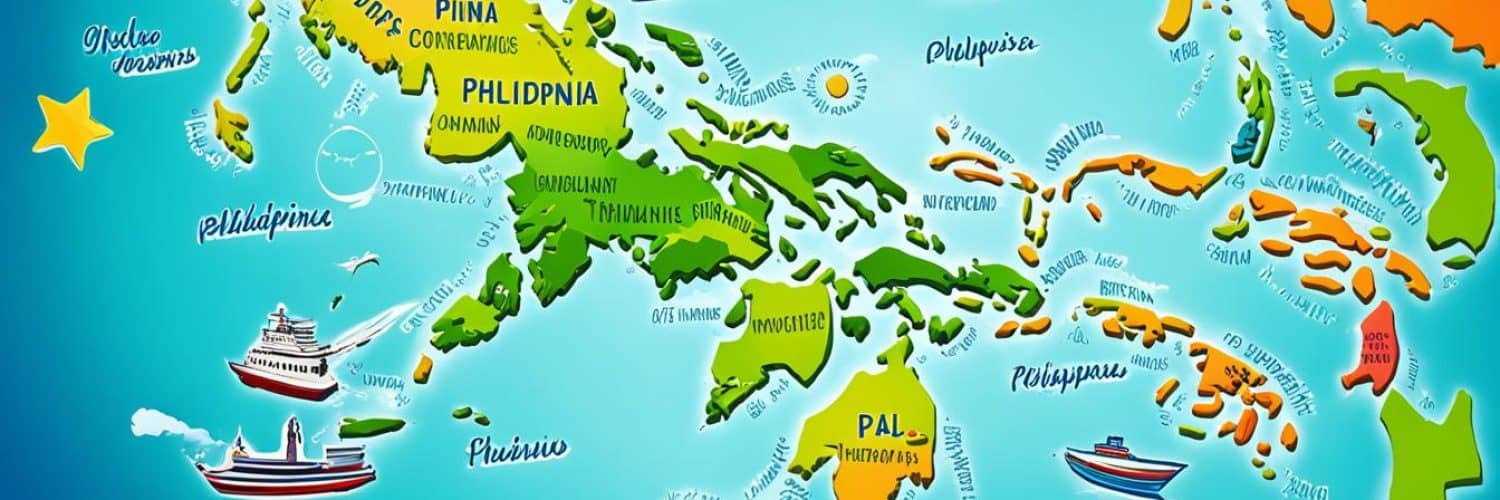Have you ever wondered why acronyms are so prevalent in the Philippines? How do Filipinos communicate efficiently using short combinations of letters? Acronyms are not just random abbreviations; they hold cultural significance and play a crucial role in daily conversations. Let’s unravel the world of acronyms in the Philippines and explore their impact on Filipino culture.
Key Takeaways:
- Acronyms are an integral part of daily communication in the Philippines
- They are used extensively in various sectors such as the government, military, educational institutions, and companies
- Understanding Filipino acronyms can enhance communication and integration within the Filipino community
- Acronyms reflect the creativity and resourcefulness of the Filipino people
- The usage of acronyms is expected to evolve in the future with technological advancements and cultural shifts
Acronyms in the Philippine Government and Military
The Philippine government and military are known for their extensive use of acronyms. These acronyms, specific to the Philippines, are unique and not used in other nations. They are an essential part of communication within government agencies, offices, programs, and military units. Understanding these acronyms is key to effective communication in these sectors.
Here are some examples of acronyms commonly used in the Philippine government and military:
| Acronym | Full Name |
|---|---|
| AFP | Armed Forces of the Philippines |
| DOH | Department of Health |
| NBI | National Bureau of Investigation |
These acronyms streamline communication, allowing for efficient and concise exchanges of information. Familiarity with these acronyms is vital when working in or interacting with the Philippine government and military.
As shown in the table, these acronyms represent key organizations and units within the Philippine government and military. They are used in a variety of contexts, from official documents to daily conversations. Understanding and utilizing these acronyms demonstrates knowledge and competence within these sectors.
“”Acronyms in the Philippine government and military facilitate effective communication and simplify references to key organizations, offices, and units. They are an integral part of the Philippine communication landscape and play a crucial role in conveying information efficiently.””
Acronyms in Churches and Religious Institutions
Acronyms play a significant role in churches and religious institutions in the Philippines. They serve as shorthand representations of different organizations, denominations, and movements within the country’s religious landscape. These acronyms are widely recognized and simplify references, allowing for efficient communication among believers.
Here are some examples of acronyms commonly used in Philippine churches and religious institutions:
- INC: Iglesia ni Cristo
- JIL: Jesus Is Lord Church Worldwide
- UCCP: United Church of Christ in the Philippines
These acronyms are deeply rooted in the Filipino religious culture and carry significant meaning for those who follow these faiths. They serve as markers of identification and affiliation, fostering a sense of community and unity.
“Acronyms in churches and religious institutions provide a concise and recognizable way to refer to specific organizations, denominations, and movements. They act as a bond that connects believers and facilitate effective communication.”
Understanding and using acronyms in religious contexts is crucial for individuals who wish to engage in meaningful conversations, participate in religious activities, and navigate the rich religious landscape of the Philippines.
| Acronym | Full Name |
|---|---|
| INC | Iglesia ni Cristo |
| JIL | Jesus Is Lord Church Worldwide |
| UCCP | United Church of Christ in the Philippines |
Acronyms in churches and religious institutions in the Philippines serve as powerful tools for effective communication, fostering a sense of belonging, and sharing a common language among believers.

Acronyms in Geography
Acronyms are not only limited to sectors like government and military in the Philippines, but they also have a significant presence in the field of geography. These acronyms play a crucial role in identifying specific geographical locations and regions, making them an essential part of conversations and discussions about Philippine geography.
Here are some examples of acronyms commonly used in Philippine geography:
| Acronym | Expansion |
|---|---|
| CALABARZON | Cavite, Laguna, Batangas, Rizal, Quezon |
| CAR | Cordillera Administrative Region |
| NCR | National Capital Region |
These acronyms are widely recognized and used in official documents, maps, and discussions related to Philippine geography. They help simplify references to specific areas, making it more convenient for individuals to communicate and navigate through conversations about geographical locations in the Philippines.
The use of acronyms in Philippine geography not only allows for efficient communication but also reflects the country’s rich cultural diversity and unique linguistic heritage.
Acronyms in Government Institutions and Corporations
Acronyms play a significant role in Philippine government institutions and corporations. They are widely used to represent various departments, agencies, and organizations, streamlining communication and facilitating efficient interaction within these sectors. Filipino government institutions utilize acronyms to refer to key departments and ministries. For instance, the Department of Budget and Management is commonly referred to as DBM, while the Department of Health is known as DOH. Similarly, corporations in the Philippines also employ acronyms as a way to identify themselves and their subsidiaries. A prominent example is SM (SM Prime Holdings), one of the largest conglomerates in the country.
By adopting acronyms within their communication practices, government institutions and corporations promote effective interaction and simplify references to complex names. These acronyms, which are widely recognized and understood within their respective sectors, play a vital role in enhancing efficiency and productivity. Furthermore, acronyms in government institutions and corporations contribute to the overall professional image and branding, creating a sense of identity and recognition.
The Impact of Acronyms in Government Institutions
“Acronyms have become an integral part of communication in our government institutions. They allow us to quickly identify and refer to specific departments, making our work more streamlined and effective. Acronyms have become our shorthand language, enabling efficient communication among our colleagues and partners.”
Benefits of Acronyms in Corporations
- Efficiency: Acronyms provide a concise and efficient way to refer to corporations and their subsidiaries, saving time and effort in communication.
- Branding: Acronyms serve as a recognizable element of corporate identity and contribute to building a strong brand presence.
- Professionalism: Using acronyms demonstrates professionalism and industry knowledge, enhancing the credibility of corporations.
- Convenience: Acronyms simplify communication by replacing lengthy company names with shorter, easy-to-remember abbreviations.
Examples of Acronyms in Government Institutions and Corporations
| Government Institutions | Acronyms |
|---|---|
| Department of Budget and Management | DBM |
| Department of Health | DOH |
| Corporations | Acronyms |
|---|---|
| SM Prime Holdings | SM |

Acronyms in Educational Institutions
Acronyms are widely used in Philippine educational institutions, playing an essential role in identifying schools, universities, and colleges across the country. These acronyms simplify references and enhance communication within the education sector. Let’s take a look at some common acronyms used in Philippine educational institutions:
| Acronym | Full Name |
|---|---|
| ADMU | Ateneo de Manila University |
| DLSU | De La Salle University |
| UP | University of the Philippines |
These acronyms, such as ADMU, DLSU, and UP, are easily recognizable and commonly used by students, teachers, and administrators in the education sector. They serve as a shorthand language that fosters efficient communication and creates a sense of identity within educational institutions.
Understanding these acronyms is especially important for students looking to pursue higher education in the Philippines. Recognizing the acronyms allows individuals to easily identify the educational institutions they are interested in and gain valuable insights into the reputation and offerings of each institution.
Moreover, teachers and administrators often refer to these acronyms when discussing educational matters, ensuring smooth and efficient communication within the school or university setting. Being familiar with the acronyms commonly used in educational institutions is beneficial for effective collaboration and information exchange among educators and staff members.
In summary, acronyms play a vital role in Philippine educational institutions, simplifying references and facilitating effective communication. Whether you’re a student, teacher, or administrator, knowing the commonly used acronyms in the education sector is essential for seamless integration and interaction within the Philippines’ educational landscape.
The Role and Significance of Acronyms in Filipino Culture
Acronyms have a significant role in Filipino culture, serving not only as an efficient means of communication but also as a reflection of the country’s unique identity. These acronyms embody the creativity and resourcefulness of the Filipino people, ingrained in daily conversations in both formal and informal settings. They have become an integral part of the national language, showcasing the diverse cultural heritage of the Philippines.
The importance of acronyms in Filipino culture cannot be overstated. They enable clear and concise communication, allowing individuals to convey messages quickly and effectively. Acronyms also foster a sense of community and belonging among Filipinos, as their usage signifies an understanding of the shared cultural references. Whether it’s abbreviating the names of government agencies, educational institutions, or even geographical locations, acronyms play a vital role in simplifying references and streamlining conversations.
In addition to their practical function, acronyms in Filipino culture hold deeper cultural significance. They represent the tenacity and adaptability of the Filipino people, showcasing their ability to creatively find ways to express complex ideas concisely. Acronyms are a testament to the vibrant and dynamic nature of the Filipino language, constantly evolving and adapting to reflect the ever-changing cultural landscape.
The Evolution of Filipino Acronyms
The evolution of Filipino acronyms showcases the cultural dynamism of the country, constantly reflecting the shifts in society, technology, and language.
Over the years, acronyms have been influenced by various factors such as globalization, technological advancements, and the permeation of English in the Filipino language. As new concepts and ideas emerge, acronyms are created to encapsulate these developments, creating a language that is unique to the Filipino culture. For example, in the age of social media and text messaging, acronyms like LOL (Laugh Out Loud), OMG (Oh My God), and TBH (To Be Honest) have become part of everyday Filipino conversations, bridging the gap between traditional and modern communication.
Acronyms not only facilitate communication but also act as a cultural identifier for Filipinos. They are a source of pride and a way to connect with others who share the same cultural background. The presence of acronyms in Filipino culture highlights the richness and complexity of the language, serving as a bridge between tradition and innovation.
| Category | Examples |
|---|---|
| Government | AFP (Armed Forces of the Philippines) |
| Education | ADMU (Ateneo de Manila University) |
| Geography | NCR (National Capital Region) |
| Religion | INC (Iglesia ni Cristo) |
As acronyms continue to evolve in Filipino culture, they remain an essential aspect of the country’s identity and communication. Understanding the role and significance of acronyms in Filipino culture not only fosters effective communication but also promotes a deeper appreciation for the rich and diverse heritage of the Philippines.

“Acronyms in Filipino culture serve as a reflection of the country’s unique identity, showcasing the creativity and resourcefulness of the Filipino people.”
Common Acronyms Used in Everyday Filipino Conversations
In everyday Filipino conversations, there are several commonly used acronyms that have become a part of the colloquial Filipino language. These acronyms are widely understood and used in informal conversations, text messaging, and social media interactions. They serve as shorthand for expressing emotions, opinions, and reactions.
Here are some examples of common Filipino acronyms:
- LOL – Laugh Out Loud
- OMG – Oh My God
- TBH – To Be Honest
These acronyms have been adopted from the English language and have seamlessly integrated into everyday Filipino conversations. They add a touch of informality and playfulness to conversations, allowing for a quick way to convey thoughts and reactions. Whether it’s expressing amusement, surprise, or honesty, these acronyms have become second nature to many Filipinos.
Understanding these common Filipino acronyms is essential for effective communication in informal settings and digital platforms. They allow for faster and more efficient exchanges, making conversations more fluid and engaging.
In the realm of social media, these acronyms are particularly popular. When used in comments, captions, or statuses, they provide a succinct way to express emotions or thoughts within the limited space provided. For instance, using “LOL” to indicate laughter saves time and characters compared to typing out the entire phrase.
“OMG! That was hilarious! LOL!”
Cultural Implications of Acronym Usage in the Philippines
In the Philippines, the usage of acronyms goes beyond mere convenience in communication. Acronyms have cultural implications and reflect the adaptability and creativity of the Filipino people in language. They serve as a unifying factor, creating a sense of identity and belonging among Filipinos.
The significance of acronyms in Philippine culture is evident in their widespread use and understanding. Acronyms contribute to the dynamism of the Filipino language, allowing for the creation of new words and expressions that reflect the cultural nuances of the country. They have become an integral part of daily conversations, both in formal and informal settings.
Acronyms in the Philippines are not just a tool for effective communication; they are a reflection of the Filipino people’s resourcefulness and ingenuity in language.
The cultural implications of acronyms can be seen in various aspects of Filipino society, including government institutions, military organizations, churches, educational institutions, and corporations. Acronyms help streamline communication within these sectors and foster a sense of community among their members.
To further illustrate the cultural significance of acronyms in the Philippines, let’s take a closer look at some examples:
| Acronym | Meaning | Significance |
|---|---|---|
| OFW | Overseas Filipino Worker | Represents the millions of Filipinos who work abroad and contribute to the country’s economy |
| BARMM | Bangsamoro Autonomous Region in Muslim Mindanao | Refers to the new autonomous political entity in the southern Philippines, reflecting the region’s unique cultural and religious background |
| K-12 | Kindergarten to Grade 12 | Represents the education system reforms in the Philippines, emphasizing the importance of early childhood education and continuous learning |
These examples demonstrate how acronyms in the Philippines carry cultural associations and represent significant aspects of Filipino society. They are a testament to the Filipino people’s ability to adapt and innovate in their language.
The cultural implications of acronyms extend beyond their functional use in communication. They contribute to the rich tapestry of Filipino culture, providing a unique linguistic identity that sets the Philippines apart from other nations. Acronyms serve as a reminder of the Filipino people’s resilience, creativity, and sense of community.
The widespread use and understanding of acronyms in the Philippines highlight the cultural significance they hold in the country.
Celebrating Linguistic Diversity
The diverse linguistic landscape of the Philippines is further enriched by the abundant use of acronyms. Different regions and communities within the country have their own unique acronyms that reflect their local culture and identity.
For instance, the Cordillera Administrative Region (CAR) in northern Luzon has acronyms specific to its ethnic groups, such as KANKANA-EY (Kalinga, Apayao, Mountain Province, Ifugao, Benguet, and Abra, with ‘EY’ meaning ‘tribe’) and BIBAK (Baguio, Ifugao, Benguet, Apayao, and Kalinga).
By embracing and celebrating linguistic diversity through acronyms, the Filipino people showcase their respect for different cultures and their dedication to fostering unity within the nation.
In the next section, we will explore some of the common acronyms used in everyday Filipino conversations, offering insights into the colloquial language of the Philippines.
Importance of Understanding Acronyms in the Philippines
Understanding acronyms is essential for effective communication in the Philippines. Familiarity with commonly used acronyms not only helps individuals navigate conversations but also enables them to comprehend written materials and engage in social interactions more confidently.
By knowing Filipino acronyms, you show respect for the local culture and demonstrate an understanding of the country’s unique cultural nuances. It allows you to connect more deeply with the Filipino community, whether for personal or professional purposes.
Benefits of knowing Filipino acronyms include:
- Improved comprehension: Knowing the meaning behind common acronyms enhances your understanding of written materials, such as government documents, corporate communications, and educational resources.
- Efficient communication: Acronyms facilitate quicker and more efficient communication, as you can convey complex concepts and information using shorter abbreviations.
- Inclusive social interactions: Understanding acronyms ensures smooth interactions with Filipinos, as acronyms are commonly used in everyday conversations, social media, and text messaging.
- Enhanced cultural integration: Being familiar with Filipino acronyms helps you integrate into the local community, fostering acceptance and building stronger connections with Filipinos.
Developing a good grasp of Filipino acronyms opens doors to deeper cultural understanding and enables you to navigate the rich linguistic landscape of the Philippines.
Advantages and Disadvantages of Acronym Usage in Communication
Acronyms can be highly advantageous in communication, offering various benefits that enhance efficiency and clarity. However, their usage can also lead to potential drawbacks and miscommunication if not utilized judiciously. Understanding the advantages and disadvantages of using acronyms in communication is essential for effective and meaningful interactions.
Advantages of Using Acronyms
- Saving time: Acronyms allow communication to be more efficient by condensing lengthy phrases or terms into concise abbreviations. This helps to streamline conversations and convey information quickly.
- Enhancing clarity: By providing a shortened representation of a concept, acronyms can enhance clarity and precision in communication, reducing the chances of ambiguity or misunderstanding.
- Facilitating quick understanding: Acronyms that are widely known and understood within a specific context or industry can facilitate quick comprehension, especially among individuals familiar with the subject matter. They enable efficient and effective communication within a specialized community.
Disadvantages of Using Acronyms
- Confusion: Acronyms that are unfamiliar to the recipient can cause confusion and hinder effective communication. It is important to consider the level of familiarity of the audience before using acronyms extensively, particularly when communicating with individuals outside a specific field or context.
- Overuse: Excessive use of acronyms can create a barrier in communication, as it may exclude individuals who are not familiar with the specific abbreviations. Over-reliance on acronyms without proper explanations may lead to misinterpretation or miscommunication.
- Misunderstandings: Lack of clarity or inconsistent understanding of acronyms can result in misunderstandings, leading to errors or incorrect assumptions. Accurate comprehension of acronyms is crucial for effective communication, ensuring that all parties involved share a common understanding.
Striking a balance in the usage of acronyms can help maximize their advantages while mitigating potential disadvantages. It is important to consider the audience, provide explanations when necessary, and ensure that acronyms do not impede the overall clarity and effectiveness of communication.
The Future of Acronyms in the Philippines
As communication continues to evolve, the usage of acronyms in the Philippines is expected to change and adapt. With the influence of digital media and emerging technologies, new acronyms are likely to emerge to reflect the evolving language and trends.
The future of acronyms in the Philippines will depend on factors such as technological advancements, language development, and cultural shifts. As new concepts and ideas emerge, acronyms will be created to encapsulate them succinctly, allowing for efficient and effective communication.
The evolving usage of acronyms in the Philippines will impact various sectors, including government, education, business, and social interactions. As society becomes more interconnected, acronyms will continue to play an important role in conveying information quickly and concisely.
In addition to facilitating communication, acronyms will also contribute to the preservation and evolution of Filipino culture. They will serve as a means of cultural expression, reflecting the values, beliefs, and creativity of the Filipino people.
The fundamental role of acronyms in enhancing communication and fostering cultural identity is expected to remain significant in the years to come. The adaptability and versatility of acronyms will ensure their continued relevance in both written and spoken language.
The Impact of Technological Advancements on Acronym Usage
The proliferation of digital media and emerging technologies will shape the future of acronyms in the Philippines. As social media platforms and online communication become increasingly prevalent, new acronyms will emerge to cater to the evolving needs of digital interactions.
The brevity and efficiency of acronyms make them particularly well-suited for text messaging, social media posts, and online discussions. The fast-paced nature of these platforms demands concise and easily understandable communication, making acronyms an essential aspect of online language.
Furthermore, as technologies such as artificial intelligence and voice recognition continue to advance, the use of spoken acronyms may become more commonplace. Voice assistants and smart devices will adapt to understand and process acronyms, further integrating them into everyday conversations.
Overall, the future of acronyms in the Philippines is closely tied to the technological advancements that shape communication. As new platforms and technologies emerge, so too will new acronyms, ensuring that communication remains efficient and concise.
| Advantages | Disadvantages |
|---|---|
|
|
“The future of acronyms in the Philippines is intertwined with technological advancements, language development, and cultural shifts.”
The future of acronyms in the Philippines holds promise and potential. With the evolving usage of acronyms, communication will become more efficient, allowing individuals to convey ideas and information rapidly. As Filipinos continue to embrace new technologies and engage in global conversations, acronyms will play a crucial role in maintaining effective communication and preserving the rich cultural heritage of the Philippines.
Conclusion
Acronyms in the Philippines are more than just abbreviations. They are a vital part of the country’s communication culture, simplifying conversations and facilitating effective communication. With acronyms, Filipinos can navigate discussions effortlessly and comprehend written materials more efficiently.
Moreover, these acronyms hold cultural significance, showcasing the Filipino people’s creativity and resourcefulness. They are symbols of the country’s unique identity and play a crucial role in fostering a sense of belonging and unity among Filipinos.
As communication continues to evolve, so will the usage of acronyms in the Philippines. Technological advancements, language development, and cultural shifts will shape the future of acronyms, allowing them to adapt to the changing landscape. However, their fundamental role in facilitating communication and reflecting Filipino culture is expected to remain significant for years to come.














Add comment